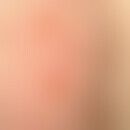Synonym(s)
DefinitionThis section has been translated automatically.
ClassificationThis section has been translated automatically.
A distinction is made between acute and chronic damage:
- Acute actinic cheilitis(Cheilitis actinica acuta) of the UV-induced acute inflammation of the red of the lips.
- Chronic actinic cheilitis (Cheilitis actinica chronica) of chronic UV-damage of the lip red with atrophy of the epithelium.
You might also be interested in
EtiopathogenesisThis section has been translated automatically.
LocalizationThis section has been translated automatically.
ClinicThis section has been translated automatically.
Cheilitis actinica acuta: oedematous swelling and redness, possible blistering a few hours after sun exposure.
Cheilitis actinica chronica: Atrophy of the skin of the lips, focal or complete covering of the red of the lips by firmly adherent keratotic plaques. Risk of carcinoma development, see below. Cheilitis abrasiva praecancerosa.
HistologyThis section has been translated automatically.
Cheilitis actinica acuta: Acanthosis, hyperkeratosis, parakeratosis in places, nonspecific superficial lymphohistiocytic infiltrates.
Cheilitis actinica chronica: Acanthosis, hyperkeratosis, local parakeratosis, superficial infiltrates.
TherapyThis section has been translated automatically.
Cheilitis actinica acuta: Moist compresses with anti-inflammatory or antiseptic additives such as polihexanide (Serasept, Prontoderm), 1% chlorhexidine or 5% dexpanthenol (e.g. Bepanthen solution) and topical glucocorticoids such as 0.25% prednicarbate (e.g. Dermatop ointment) or 0.1% mometasone (e.g. Ecural lipid cream).
Cheilitis actinica chronica: In case of mild manifestation without keratotic overgrowth: Only care measures with lipsticks that are greasy and protect against light (e.g. Ceralip lip cream, Ilrido lip protection stick, Neutrogena total sun protection stick). If necessary, application of diclofenac gel (Solaraze [2.5% hyaluronic acid as a carrier]) 2 times a day.
Cheilitis actinica chronica with adherent keratoses: In this case, the treatment aims to stop the progression of precancerous changes to the development of invasive squamous cell carcinoma of the lips by eradication of the primary lesion(s).
Ablative procedures: as ablative surgical measures have been proven in the hands of experienced:
- CO2 laser ablation
- Cryosurgery (the cryosurgical measures (open spray procedure) is considered by many as a "first step" therapy: depending on the severity of the actinic changes 1 or 2 short therapy cycles (see also below cryosurgery).
- Electrodesiccation (well suited for smaller lesions).
Non-ablative procedures: as non-ablative procedures have proven to be:
- Chemical peeling,
- Topical imiquimod
- Diclofenac gel (Solaraze [2.5% hyaluronic acid as carrier]) 2 times daily.
- 5-Fluorouracil (Efudix®; apply 1 time/day until erosive reaction).
- Photodynamic therapy (PDT). Daylight-activated PDT, using natural daylight as the light source, has shown promising results in the past and is now established as a suitable and safe method (Levi A et al. 2019; Martín-Carrasco Pet al. 2020). Cure rates of around 90% have been achieved in small case studies.
For pronounced extensive verrucous keratoses , vermillonectomy is recommended. In this procedure, the lip red is removed in strips in a horizontal direction, the lip mucosa is mobilized forward as a lip substitute and sutured to the skin. Light protection and care of the lips see above.
Remark. In case of cheilitis actinica chronica always histological exclusion of a spinocellular carcinoma!
Internal therapyThis section has been translated automatically.
ProphylaxisThis section has been translated automatically.
LiteratureThis section has been translated automatically.
- de Sevaux RG et al (2003) Acitretin treatment of premalignant and malignant skin disorders in renal transplant recipients: clinical effects of a randomized trial comparing two doses of acitretin. J Am Acad Dermatol 49: 407-412
- Hohenleutner S et al (1999) CO(2) laser vaporisation of actinic cheilitis. Dermatologist 50: 562-565
- Johnson TM et al (1992) Carbon dioxide laser treatment of actinic cheilitis. Clinicohistopathologic correlation to determine the optimal depth of destruction. J Am Acad Dermatol 27: 737-740
Levi A et al. (2019) Daylight photodynamic therapy for the treatment of actinic cheilitis. Photodermatol Photoimmunol Photomed 35:11-16.
Martín-Carrasco Pet al (2020) Actinic cheilitis treated with daylight photodynamic therapy. Actas Dermosifiliogr (Engl Ed) 111:883-885.
Radakovic S et al (2017) 5-aminolaevulinic acid patch-photodynamic therapy in the treatment of actinic cheilitis. Photodermatol Photoimmunol Photomed. 33:306-310.
- Smith KJ et al (2002) Topical 5% imiquimod for the therapy of actinic cheilitis. J Am Acad Dermatol 47: 497-501
Incoming links (11)
Acutal cheilitis actinica; Carcinoma in situ; Cheilitis abrasiva praecancerosa; Cheilitis actinica chronica; chronische aktinische Cheilitis; ; Cheilitis actinica (overview); Cheilitis photoactinica; Cheilits actinica acuta; Colloidalmilium; Exfoliative cheilitis; Lip carcinoma; ... Show allOutgoing links (13)
Acanthosis; Acetylsalicylic acid; Analgesics; Bubble; Cheilitis abrasiva praecancerosa; Cheilitis actinica chronica; chronische aktinische Cheilitis; ; Cheilitis actinica (overview); Cryosurgery; Glucocorticosteroids systemic; Light stabilizers; ... Show allDisclaimer
Please ask your physician for a reliable diagnosis. This website is only meant as a reference.
















